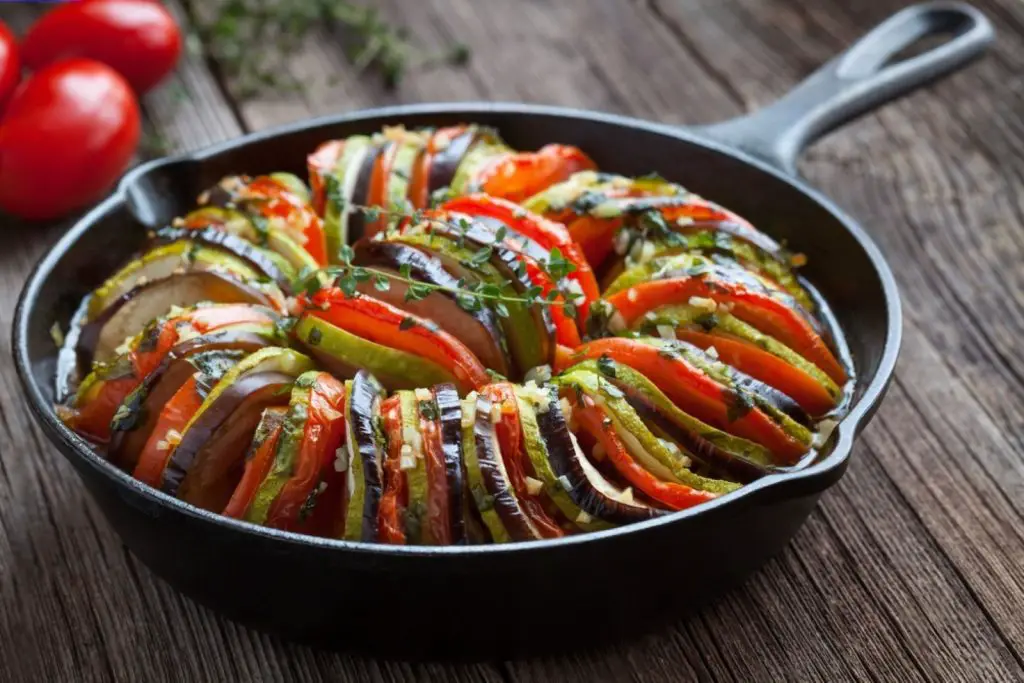
Sofrito is a flavorful base used in many traditional Latin American, Spanish, and Caribbean dishes. It typically consists of a mix of onions, garlic, peppers, tomatoes, and other herbs and spices. The aromatic blend of ingredients adds depth and richness to various recipes, making it a popular addition to stews, rice dishes, soups, and more. However, if you find yourself with excess sofrito or want to have it readily available for future use, freezing it is an excellent option. By following these simple steps, you can preserve the vibrant flavors of sofrito and have it on hand whenever you need to add a burst of taste to your cooking. Let’s explore the process of freezing sofrito for optimal results.
Here’s a guide on freezing sofrito:
Step 1: Prepare the Fresh Sofrito
Preparing the fresh sofrito is the essential first step before freezing it. Sofrito is a flavorful base used in various cuisines, particularly in Latin American, Spanish, and Caribbean dishes. It serves as a foundation for many recipes, adding depth and complexity to the final dishes. While the specific ingredients used in sofrito may vary from one recipe to another and across different regions, the most common elements include onions, garlic, bell peppers, tomatoes, cilantro, and sometimes additional herbs like oregano or culantro.
To begin, gather all the necessary ingredients in their appropriate quantities. The onions, garlic, bell peppers, and tomatoes should be fresh and ripe, as they contribute to the overall flavor and aroma of the sofrito. The cilantro and optional herbs should also be fresh to impart their unique tastes to the mixture.
Next, finely chop all the vegetables and herbs to ensure even cooking and to create a uniform texture. Some cooks prefer to use a food processor to save time and ensure a consistent blend of ingredients. The finely chopped or processed mixture allows the flavors to meld together more effectively during the cooking process.
The blending of these ingredients is crucial as it creates a harmonious flavor profile that serves as the base for many delicious dishes. The onions provide a sweet and aromatic note, while the garlic adds a rich, pungent taste. Bell peppers contribute a mild and slightly sweet flavor, and tomatoes bring a tangy and vibrant element to the mix. Cilantro and optional herbs infuse the sofrito with refreshing and herbaceous undertones.
Sofrito is traditionally cooked in oil to release and enhance its flavors. As the ingredients cook, they break down and release their natural oils, infusing the entire mixture with a mouthwatering aroma. This step also softens the vegetables, making them tender and easier to incorporate into various recipes.
Step 2: Cook the Sofrito
Cooking the sofrito before freezing is an important step that not only enhances its flavors but also helps preserve its quality during the freezing process. By sautéing the sofrito mixture in oil, the ingredients undergo a transformation that intensifies their taste and creates a rich, aromatic base for various dishes.
When the sofrito is added to a hot pan with a tablespoon of olive oil or vegetable oil, the heat begins to release the natural oils and essential oils present in the vegetables and herbs. As a result, the kitchen fills with a delightful fragrance that promises a delicious outcome.
Sautéing the sofrito also allows the onions, garlic, bell peppers, and tomatoes to soften and caramelize slightly. The process breaks down their cell walls, making them tender and more easily incorporated into other recipes. The slight caramelization adds a hint of sweetness and depth to the sofrito, enhancing its overall flavor profile.
As the sofrito cooks, the individual flavors of the ingredients blend together, creating a harmonious symphony of tastes. The pungent garlic mellows out, the sweetness of the onions balances with the tanginess of the tomatoes, and the herbs infuse the mixture with their distinctive notes. This cooking process melds the flavors, ensuring that each spoonful of sofrito packs a powerful punch of taste.
Cooking the sofrito also helps remove excess moisture from the mixture. Moisture can be detrimental during the freezing process, as it can lead to freezer burn and negatively impact the quality of the frozen sofrito. By sautéing the mixture, some of the water content evaporates, reducing the risk of freezer burn and ensuring that the sofrito retains its vibrant flavors and texture when thawed and used in future dishes.
The recommended sautéing time of about 5 to 7 minutes is sufficient to achieve the desired results without overcooking the sofrito. Overcooking can lead to the loss of some flavors and result in a mushy texture, which is best avoided.
Can I freeze sofrito without cooking it first?
It is not advisable to freeze sofrito without cooking it first. The cooking process helps release flavors, soften ingredients, and enhance the sofrito’s overall taste. Freezing uncooked sofrito can lead to off-flavors and a less appealing texture when thawed.
Step 3: Cool the Sofrito
Cooling the cooked sofrito thoroughly is a crucial step in the freezing process to ensure the safety and quality of the preserved mixture. Rapidly cooling the sofrito helps prevent the growth of harmful bacteria and ensures that the flavors are preserved at their best.
When the sofrito is cooked, it reaches a high temperature due to the sautéing process. Allowing it to cool down before freezing is essential because placing hot food directly in the freezer can raise the overall temperature inside the freezer. This sudden increase in temperature can affect other frozen items and lead to partial thawing, potentially compromising their quality and safety.
Transferring the cooked sofrito to a wide, shallow container is a smart choice for speeding up the cooling process. A shallow container allows more surface area for the sofrito to be exposed to the air, promoting quicker heat dissipation. As the sofrito cools down, it is essential to stir it occasionally to help distribute the heat evenly and prevent any potential hot spots that might prolong the cooling time.
Deep containers, on the other hand, tend to retain heat, which can slow down the cooling process and create uneven cooling within the sofrito. Uneven cooling can lead to variations in texture and flavor, making the sofrito less appealing when it’s eventually thawed and used in dishes.
It’s worth mentioning that cooling the sofrito to room temperature is essential before transferring it to the freezer. Placing hot sofrito directly in the freezer could raise the temperature of the freezer and affect the quality of other frozen items already present.
Step 4: Portion the Sofrito
Portioning the cooled sofrito into smaller, manageable portions is a practical and convenient approach for freezing. By dividing the sofrito based on your typical usage, you ensure that you can easily access the right amount of sofrito needed for different recipes without thawing more than necessary.
Considering your typical usage is crucial when portioning the sofrito. Think about the recipes you frequently cook that require sofrito as a base. Whether it’s a soup, stew, rice dish, or sauce, determining the approximate amount of sofrito needed for each recipe helps you create portion sizes that align with your cooking habits.
Small freezer-safe containers or ice cube trays are excellent choices for storing the sofrito portions. Freezer-safe containers with airtight lids prevent freezer burn and maintain the quality of the sofrito over an extended period. The advantage of using ice cube trays lies in their convenient size. Each compartment in the ice cube tray holds a small amount of sofrito, making it easy to control the portions precisely.
When using ice cube trays, it’s essential to fill each compartment with sofrito, leaving some space for expansion during freezing. Liquids, including the natural juices released by the vegetables in the sofrito, tend to expand as they freeze. Leaving some space at the top of the ice cube compartments prevents spillage and ensures that the sofrito doesn’t expand too much, which could lead to the containers cracking or bursting.
By portioning the sofrito, you also enable selective defrosting. If you only need a small amount of sofrito for a quick dish, you can take out a single portion from the freezer instead of thawing an entire container. This minimizes waste and allows you to make the most out of your frozen sofrito supply.
Additionally, smaller portions thaw faster than larger ones, reducing the time required to prepare your meals. Quick and easy access to small portions of sofrito streamlines your cooking process, making it more convenient to whip up a delicious meal whenever you need it.
Can I freeze sofrito in glass jars?
Yes, you can freeze sofrito in glass jars, but you must use jars specifically designed for freezing. Leave enough headspace in the jar to allow for expansion during freezing, and avoid using regular glass jars that may shatter due to temperature changes.
Can I freeze sofrito in silicone molds?
Yes, silicone molds can be used to freeze sofrito, especially for creating small, individual portions. Once the sofrito is fully frozen in the molds, remove the portions and transfer them to freezer bags for long-term storage.
Step 5: Freeze the Sofrito
Freezing the portioned sofrito promptly is essential to preserving its flavors, textures, and overall quality. When the sofrito is frozen quickly, it forms smaller ice crystals, which helps maintain the integrity of the ingredients and prevents the formation of large ice crystals that can cause cell walls to rupture and lead to a loss of flavor and texture.
Placing the portioned sofrito containers or ice cube trays in the freezer as soon as possible after portioning is crucial. Delaying the freezing process allows the sofrito to remain at a higher temperature for an extended period, which can lead to bacterial growth and potential spoilage. Freezing the sofrito promptly also prevents any loss of essential oils and volatile compounds responsible for its distinctive aroma and taste.
If your freezer has a “quick freeze” or “turbo” setting, take advantage of it for this step. The “quick freeze” function rapidly lowers the freezer’s temperature, creating an optimal environment for freezing food quickly. By using this setting, you ensure that the sofrito reaches the ideal freezing temperature more efficiently, maintaining its quality for a more extended period.
When the sofrito freezes quickly, the formation of smaller ice crystals minimizes damage to the cell structure of the ingredients. This preservation of cell integrity contributes to better texture and flavor retention when the sofrito is thawed and used in recipes.
Step 6: Transfer to Freezer Bags
Transferring the fully frozen sofrito portions from their initial containers or ice cube trays to freezer bags is a practical and efficient way to store them for the long term. Freezer bags offer excellent protection against freezer burn and help maintain the quality and flavor of the sofrito.
If you used ice cube trays for freezing the sofrito, gently pop out the individual sofrito cubes. Ice cube trays are convenient for portioning, but transferring the frozen sofrito cubes to freezer bags allows you to free up the ice cube tray for other uses and maximize the freezer space.
Freezer-safe plastic bags are an excellent choice because they are designed to withstand freezing temperatures without becoming brittle or prone to tearing. They also provide a tight seal that prevents air from entering the bag, helping to preserve the sofrito’s flavor and texture.
Squeezing out as much air as possible from the freezer bags before sealing them is crucial for several reasons. Air contains moisture, and any excess air left in the bags could lead to freezer burn, which can affect the taste and texture of the sofrito over time. Removing air from the bags also reduces the risk of ice crystals forming on the sofrito, as these ice crystals can lead to a mushy and less desirable texture.
If you are using small containers instead of freezer bags, ensure that they have airtight lids. Airtight containers prevent air from entering and coming into contact with the sofrito, helping to maintain its quality during storage.
Properly sealed and airtight freezer bags or containers keep the sofrito protected from freezer odors and prevent it from absorbing unwanted smells. This ensures that the sofrito retains its authentic flavor and is ready to add a burst of taste to your dishes whenever you need it.
Step 7: Label and Date
Labeling the freezer bags or containers with the contents and date of freezing is a simple yet essential step in the process of freezing sofrito. It provides crucial information that helps you keep track of the contents in your freezer and ensures you use the sofrito in a timely manner for the best quality and taste.
By labeling the bags or containers with “Sofrito” or any other identifying term, you can easily distinguish the sofrito from other frozen items in your freezer. This is especially helpful if you have multiple types of frozen ingredients, as it saves time and avoids confusion when searching for specific items during meal preparation.
Additionally, noting the date of freezing on the label is essential for managing the shelf life of the sofrito. Frozen food, including sofrito, can retain its quality for a certain period, but it’s best to use it within a reasonable timeframe. With the date clearly labeled, you can easily identify how long the sofrito has been frozen and prioritize using the oldest portions first.
Using the “first-in, first-out” (FIFO) principle is a common practice when managing frozen items. This means using the oldest items first to ensure they are consumed before their quality starts to degrade. By following the FIFO principle and using the oldest portions of frozen sofrito, you maximize the enjoyment of its flavors and ensure that none of it goes to waste.
Properly labeled freezer bags or containers also come in handy when planning meals. Knowing the quantity of sofrito available and its freezing date can help you adjust your recipes and cooking plans accordingly. It allows you to plan ahead and ensure you have enough sofrito for various dishes in your meal planning.
Labeling is particularly helpful when freezing sofrito in smaller portions, such as in ice cube trays. Each portion might contain a relatively small amount, and the labeling ensures you don’t overlook or forget about any of these valuable frozen flavor boosters.
Step 8: Store in the Freezer
Proper storage of the frozen sofrito is crucial to maintaining its quality, flavors, and safety for an extended period. To ensure the best preservation, it’s essential to place the labeled sofrito bags or containers in the optimal area of the freezer.
The temperature in the freezer can vary depending on its location. The back of the freezer tends to be the coldest and most consistent area, making it the ideal spot to store the sofrito. Placing the sofrito in this area ensures that it remains at a stable and low temperature, preventing any potential thawing and refreezing that can compromise its texture and taste.
On the other hand, the freezer door is more prone to temperature fluctuations. Every time the freezer door is opened and closed, warm air from the surrounding environment can enter, causing the temperature inside to rise temporarily. This fluctuation in temperature can affect the quality of the frozen sofrito over time, leading to a potential loss of flavor and texture.
By storing the sofrito away from the freezer door, you minimize its exposure to these temperature fluctuations, ensuring a more consistent and stable freezing environment. This practice helps maintain the sofrito’s quality and extends its shelf life, allowing you to enjoy its delicious flavors for an extended period.
Organizing the freezer with labeled sofrito bags or containers also makes it easier to access and use the sofrito efficiently. Knowing where each portion of sofrito is located saves time and reduces the need to rummage through the freezer when you need it.
Additionally, placing the sofrito in a dedicated compartment or section of the freezer keeps it separate from other frozen items. This minimizes the risk of cross-contamination and helps prevent the sofrito from absorbing any unwanted odors or flavors from other foods.
Properly frozen sofrito can last for several months without a significant loss of flavor. However, it’s essential to note that while the flavors may remain intact, frozen foods can experience some changes in texture over time. To ensure the best quality, it’s advisable to use the frozen sofrito within 3 to 6 months, as this period typically guarantees the best taste and texture.
Other related questions
How do I defrost sofrito?
To defrost sofrito, use either the refrigerator method or the microwave method. In the refrigerator method, transfer the frozen sofrito to the fridge and allow it to thaw slowly overnight or for several hours. For a quicker option, use the microwave’s defrost setting in short intervals, stirring between each interval to ensure even thawing. Avoid defrosting sofrito at room temperature to prevent bacterial growth.
Can I refreeze sofrito?
No, it is not recommended to refreeze sofrito. Repeated freezing and thawing can compromise its quality, taste, and texture. Once sofrito is thawed, it should be used promptly and not refrozen to ensure the best culinary experience.
How do I know if the sofrito has gone bad after being frozen?
To determine if frozen sofrito has gone bad, look for signs of spoilage such as off smells, unusual colors, or changes in texture. If the sofrito develops a sour or rancid odor, or if it appears moldy or discolored, it should be discarded. Additionally, if the texture becomes mushy or grainy, it may no longer be suitable for use and should be replaced.
Can I freeze sofrito with meat or other ingredients included?
Yes, you can freeze sofrito that includes meat or other ingredients. However, it’s essential to consider the type of ingredients being included. Cooked meats, vegetables, and herbs can be incorporated into the sofrito before freezing. For raw meats, it is recommended to cook them before adding them to the mixture, as freezing raw meat can affect its quality and safety. Once all the ingredients are combined, the sofrito can be portioned and frozen following the standard freezing procedures to ensure optimal preservation.
Can I freeze sofrito with seafood or fish?
Yes, you can freeze sofrito with seafood or fish. However, it’s best to add seafood or fish to the sofrito just before using it in a recipe, rather than freezing them together. Seafood and fish can have delicate textures that may not freeze well, so adding them fresh ensures better quality in the final dish.
Can I freeze sofrito made with vinegar or citrus juice?
Yes, you can freeze sofrito made with vinegar or citrus juice. These acidic ingredients may slightly affect the texture of the sofrito after freezing, but the overall flavor should remain intact. Thaw the sofrito in the refrigerator before use and stir it to restore its original consistency.
Can I freeze sofrito with beans or legumes?
Yes, you can freeze sofrito with beans or legumes. However, it’s recommended to cook the beans or legumes separately and add them to the sofrito before using it in a recipe. Freezing raw or uncooked beans in the sofrito can lead to inconsistent textures and prolonged cooking times.
Can I freeze sofrito with dairy or cream?
It’s best to avoid freezing sofrito with dairy or cream. Dairy products can separate and change in texture when frozen, resulting in an undesirable consistency. Instead, add dairy or cream to the sofrito when using it in a recipe after thawing.








